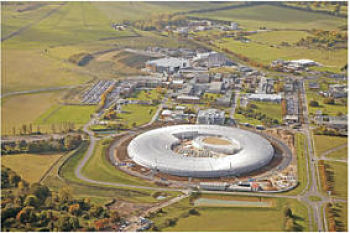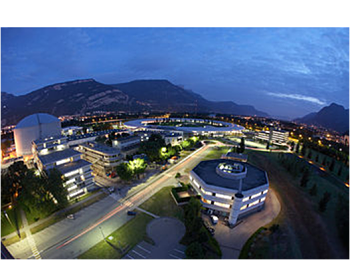Institutues
ISIS - Oxfordshire, UK.
The ISIS pulsed neutron source at the Rutherford Appleton Laboratory in Oxfordshire is a world-leading centre for research in the physical and life sciences.

It is owned and operated by the UK Goverment's Science and Technology Facilities Council. ISIS produces beams of neutrons (and muons) which allow scientists to study materials at the atomic level using a suite of instruments, often described as ‘super-microscopes’. It supports a national and international community of more than 2000 scientists who use neutrons and muons for research in physics, chemistry, materials science, geology, engineering and biology. It is the most productive research centre of its type in the world. From the original vision over 30 years ago, ISIS has become one of the UK’s major scientific achievements. As the world’s leading pulsed neutron and muon source, ISIS has changed the way the world views neutron scattering.
In a accelerator-based pulsed neutron source, neutrons are released by bombarding a heavy-metal target (e.g., U, Ta, W), with high energy particles (e.g., H+) from a high-power accelerator – a process known as spallation. The methods of particle acceleration can be used to produce short intense bursts of high-energy protons, and hence pulses of neutrons. Spallation releases much less heat per useful neutron than the other process of fission (typically 30 MeV per neutron, compared with 190 MeV in fission). The low heat dissipation means that pulsed sources can deliver high neutron brightness – exceeding that of the most advanced steady-state sources – with significantly less heat generation in the target. The most powerful spallation neutron source in the world is the ISIS facility. It is based around a 200 µA, 800 MeV, proton synchrotron operating at 50 Hz, and a tantalum (Ta) target which releases approximately 12 neutrons for every incident proton. To find out more information about ISIS, click here.
ILL - Grenoble, France.
The Institut Laue-Langevin is an internationtal research centre at the leading edge of neutron science and technology.
As the world's flagship centre for neutron science,the ILL provides scientists with a very high flux of neutrons feeding some 40 state-of-the-art instruments, which are constantly being developed. Every year, some 1500 researchers from over 40 countries visit the ILL. More than 800 experiments selected by a scientific review committee are performed annually. Research focuses primarily on fundamental science in a variety of fields: condensed matter physics, chemistry, biology, nuclear physics and materials science, etc. Whilst some are working on engine designs, fuels, and household products, others are looking at biological processes at the cellular/molecular level. Still others may be elucidating the physics that could contribute to the electronic devices of the future. ILL can specially tailor its neutron beams to probe the fundamental processes that help to explain how our universe came into being, why it looks the way it does today and how it can sustain life.

In a reactor-based neutron source, neutrons are produced by fission in nuclear reactors optimised for high neutron brightness. In this process, thermal neutrons are absorbed by uranium-235 nuclei, which split into fission fragments and evaporate a very high-energy (MeV) constant neutron flux. After the high-energy (MeV) neutrons have been thermalised to meV energies in the surrounding moderator, beams are emitted with a broad band of wavelengths. The energy distribution of the neutrons can be shifted to higher energy (shorter wavelength) by allowing them to come into thermal equilibrium with a “hot source” (at the ILL this is a graphite block at 2400 K), or to lower energies with a “cold source” such as liquid deuterium at 25 K. Wavelength selection is generally achieved by Bragg scattering from a crystal monochromator or by velocity selection through a mechanical chopper. In this way high-quality, high-flux neutron beams with a narrow wavelength distribution are made available for scattering experiments. The most powerful of the reactor neutron sources in the world today is the 58 MW HFR (High-Flux Reactor) at the ILL.